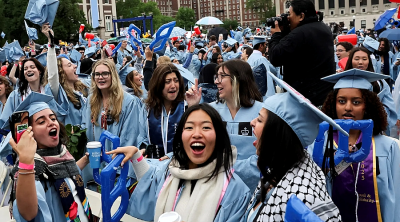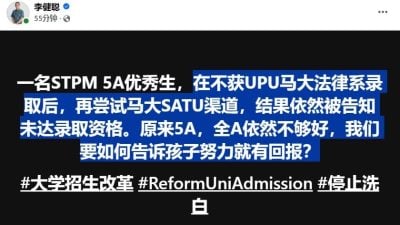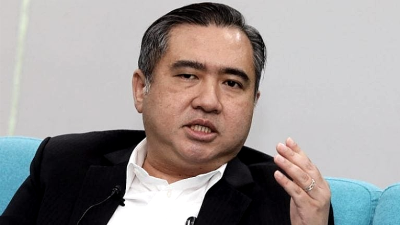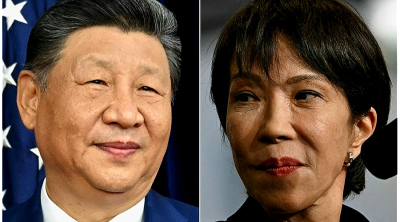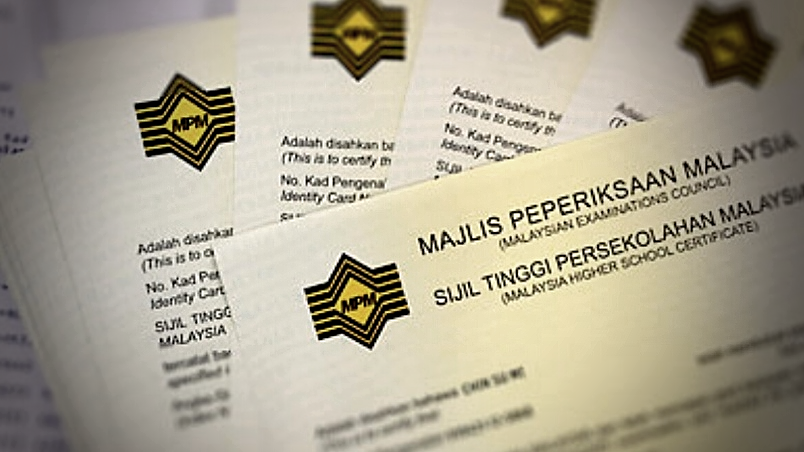
I believe that even if the University of Malaya (UM) does not admit Edward Wong Yi Xian, there will be other universities, especially private ones, willing to accept him—perhaps even offering him a scholarship to study his first-choice course in accounting.
Offering Wong a scholarship to study in other universities may solve Wong’s personal problem, but it doesn’t solve the bigger issue—the problem with STPM.
There have been many similar cases in the past, and there will be many more in the future. Solving Wong’s case leaves hundreds or even thousands more unresolved.
As long as STPM continues to exist, the plight of students like Wong will persist. And his plight represents the broader struggle faced by non-Bumiputera students in accessing higher education.
So, what exactly is the problem with STPM?
It is the most difficult stage before university. The standards are very high, the study period is long, but the university admission rate—especially for popular courses—is very low.
In economics or life lessons, we learn that higher investment should yield higher returns. But STPM is a high-investment, low-return path.
Take Wong’s case for example—he scored a perfect CGPA of 4.0, yet all six public universities he applied to for accounting rejected him. UM offered him a place through the SATU pathway, but with the same fees as international students—ten times more expensive.
If he had to go through direct intake channel called SATU, then enduring the grueling STPM process was unnecessary in the first place.
Wong’s experience shows that STPM is not only sidelined by the matriculation program but is also squeezed out by university foundation programs (Asasi), and further deprived of seats by SATU, which primarily enrolls international students.
It’s like a whole chicken—the drumsticks go to matriculation, the breast to Asasi, the wings to SATU, and what’s left—the bony scraps—are thrown to STPM.
In cases like Wong’s, the UPU, a platform which handles application to public universities, claims it only manages 85 seats and that the supply-demand imbalance is not its fault.
UM pushes the blame around and finally admits to having 163 seats—but these are allocated across different admission pathways.
Priority goes to matriculation students, then their own Asasi students, followed by revenue-generating SATU admissions. STPM is left with no backing and no commercial value—like a tasteless chicken rib.
STPM is a product of an unfair educational opportunity system.
For non-Bumiputera students—especially those from less privileged economic backgrounds—STPM is often the only way into public universities. But that also makes them the first to be sacrificed under an unfair system.
For non-Bumiputera students, especially those from less privileged economic backgrounds, STPM is often the only way into public universities. But that also makes them the first to be sacrificed under an unfair system.
Each year, more than 40,000 students place their hopes on STPM. Yet, this system lets them down.
Many of these students are capable and hardworking—they could have used higher education to build better lives, change the fate of their families, and contribute more to society. But they fall at the hurdle called STPM.
If STPM didn’t exist—or if there were a fairer system—their lives might have turned out differently.
Those with the potential to become doctors could have become doctors; those fit to be engineers or accountants could have pursued those paths.
Continuing with the current form of STPM is unfair to students—and it’s not good for social stability or national development.
STPM is full of flaws. Under a rigid system, it has no room for improvement. With a lack of transparency and continuous marginalization, it remains sidelined.
Given the current situation, it may be time to consider abolishing STPM and replacing it with a more robust and equitable system.
This is neither an emotional outburst nor an impractical suggestion.
If there is social consensus and the government is genuine, STPM could be abolished and replaced by an expanded matriculation system.
Given the political reality, matriculation could maintain a quota system—but the quota ratio must be reasonable and transparent.
Both Bumiputera and non-Bumiputera students could enter the matriculation program, then apply to universities. If conditions are clearly outlined and implemented transparently, disputes would lessen.
Alternatively, the government could abolish the matriculation program and fully implement STPM—with all ethnic groups applying to universities based on STPM results.
However, since matriculation is now the mainstream, abolishing it would be more difficult than abolishing STPM.
Another option would be to abolish both matriculation and STPM and have all students apply to university foundation programs (pre-university) based on their SPM results.
Public universities could still maintain quotas, but admissions would follow a transparent and fair standard.
SATU would remain—but only for international students—and local taxpayers should not be charged exorbitant fees under this pathway.
Beyond these three options, there may be other alternatives.
Scholars, political parties, and public policy decision-makers should come together to discuss and design a fairer system—one that serves the country’s needs better than the current STPM.
ADVERTISEMENT
ADVERTISEMENT








